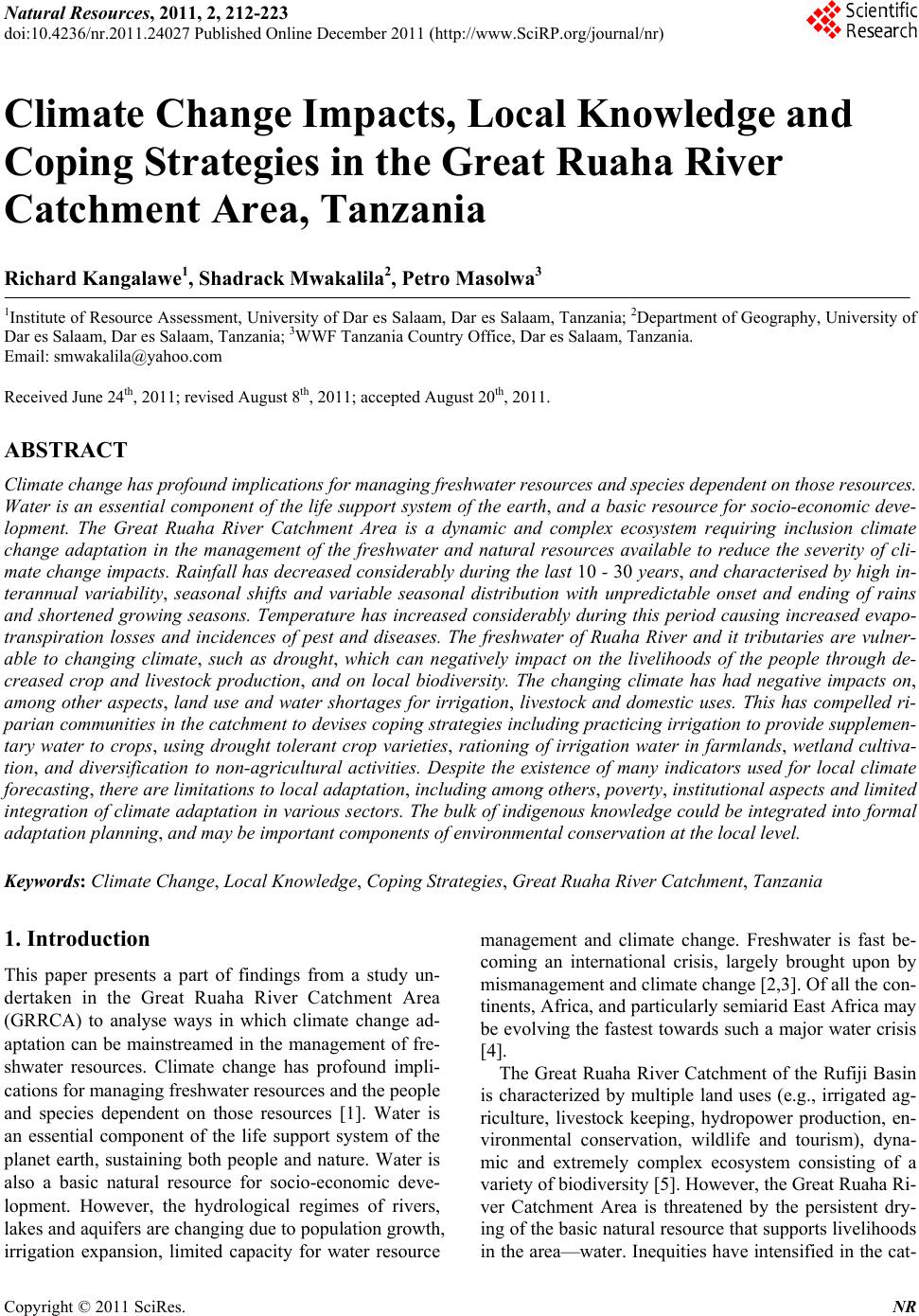 Natural Resources, 2011, 2, 212-223 doi:10.4236/nr.2011.24027 Published Online December 2011 (http://www.SciRP.org/journal/nr) Copyright © 2011 SciRes. NR Climate Change Impacts, Local Knowledge and Coping Strategies in the Great Ruaha River Catchment Area, Tanzania Richard Kangalawe1, Shadrack Mwakalila2, Petro Masolwa3 1Institute of Resource Assessment, University of Dar es Salaam, Dar es Salaam, Tanzania; 2Department of Geography, University of Dar es Salaam, Dar es Salaam, Tanzania; 3WWF Tanzania Country Office, Dar es Salaam, Tanzania. Email: smwakalila@yahoo.com Received June 24th, 2011; revised August 8th, 2011; accepted August 20th, 2011. ABSTRACT Climate change has profound implications for managing freshwater resources and species dependent on those resources. Water is an essential componen t of the life support system of the ea rth, and a basic resource for socio-economic deve- lopment. The Great Ruaha River Catchment Area is a dynamic and complex ecosystem requiring inclusion climate change adaptation in the management of the freshwater and natural resources available to reduce the severity of cli- mate change impacts. Rainfall has decreased considerably during the last 10 - 30 years, and characterised by high in- terannual variability, seasonal shifts and variable seasonal distribution with unpredictable onset and ending of rains and shortened growing seasons. Temperature has increased considerably during this period causing increased evapo- transpiration losses and incidences of pest and diseases. The freshwater of Ruaha River and it tributaries are vulner- able to changing climate, such as drought, which can negatively impact on the livelihoods of the people through de- creased crop and livestock production, and on local biodiversity. The changing climate has had negative impacts on, among other aspects, land use and water shortages for irrigation, livestock and domestic uses. This has compelled ri- parian communities in th e catchment to devises co ping strategies in cluding practicing irriga tion to provide supp lemen- tary water to crops, using drought tolerant crop varieties, rationing of irrigation water in farmlands, wetland cultiva- tion, and diversification to non-agricultural activities. Despite the existence of many indicators used for local climate forecasting, there are limitations to lo cal adaptation, including among others, poverty, institutional aspects and limited integration of climate adaptation in various sectors. The bulk of indigenous knowledge could be integrated into formal adaptati o n pl anning, and may be important components of environmental conservation at the local level. Keywords: Climate Change, Local Knowledge, Coping Strategies, Great Ruaha River Catchment, Tanzania 1. Introduction This paper presents a part of findings from a study un- dertaken in the Great Ruaha River Catchment Area (GRRCA) to analyse ways in which climate change ad- aptation can be mainstreamed in the management of fre- shwater resources. Climate change has profound impli- cations for managing freshwater resources and the people and species dependent on those resources [1]. Water is an essential component of the life support system of the planet earth, sustaining both people and nature. Water is also a basic natural resource for socio-economic deve- lopment. However, the hydrological regimes of rivers, lakes and aquifers are changing due to population growth, irrigation expansion, limited capacity for water resource management and climate change. Freshwater is fast be- coming an international crisis, largely brought upon by mismanagement and climate change [2,3]. Of all the con- tinents, Africa, and particularly semiarid East Africa may be evolving the fastest towards such a major water crisis [4]. The Great Ruaha River Catchment of the Rufiji Basin is characterized by multiple land uses (e.g., irrigated ag- riculture, livestock keeping, hydropower production, en- vironmental conservation, wildlife and tourism), dyna- mic and extremely complex ecosystem consisting of a variety of biodivers ity [5]. However, the Great Ruaha Ri- ver Catchment Area is threatened by the persistent dry- ing of the basic natural resource that suppo rts livelihood s in the area—water. Inequities ha ve intensified in the cat- 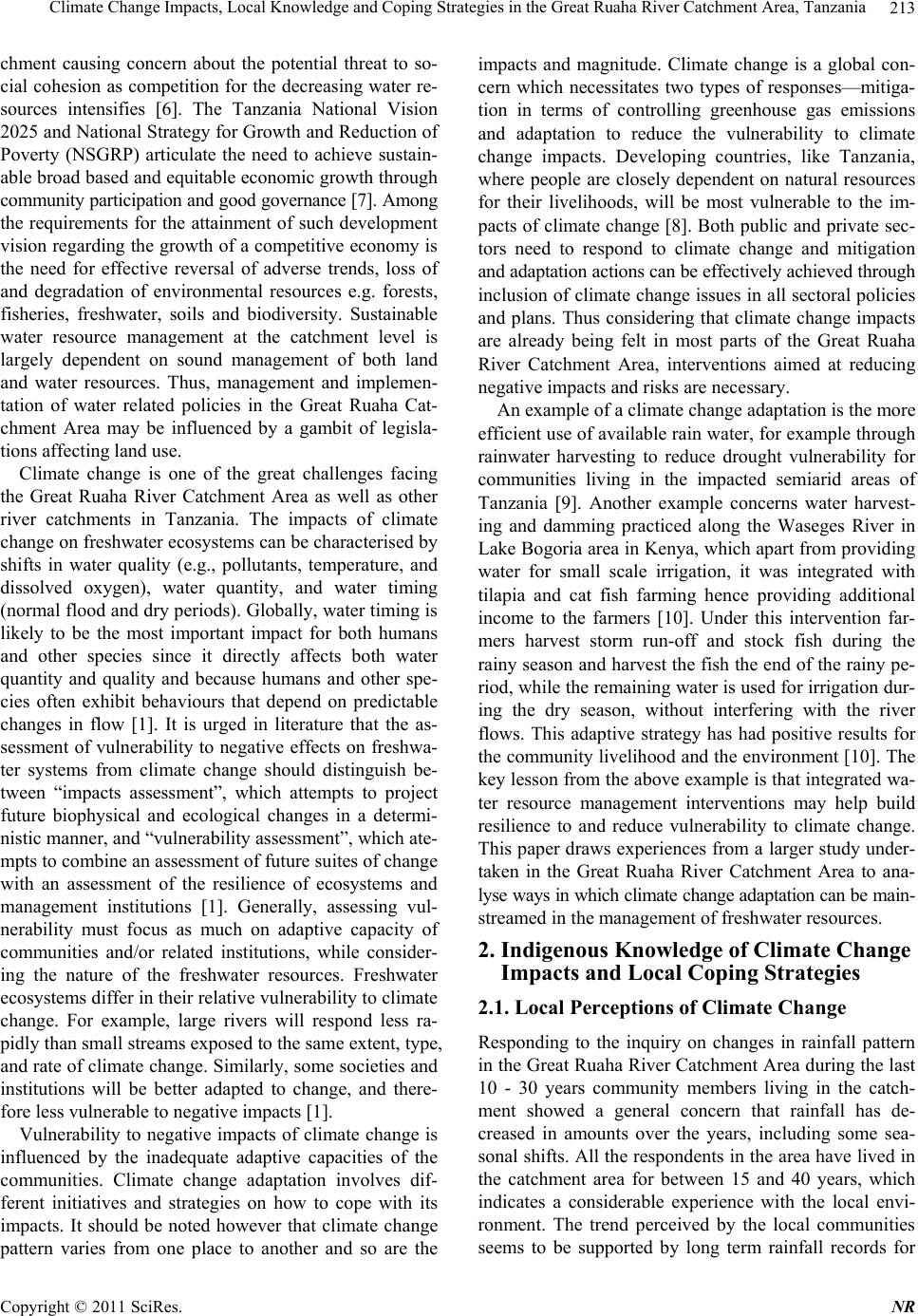 Climate Change Impac ts, Local Knowledge and Coping Strategies in the Great Ruaha River Catchment Area, Tanzania213 chment causing concern about the potential threat to so- cial cohesion as competition for the decreasing water re- sources intensifies [6]. The Tanzania National Vision 2025 and National Strategy for Growth and Reduction of Poverty (NSGRP) articulate the need to achieve sustain- able broad based an d equitable economic grow th through community participation and good governance [7]. Among the requirements for the attainment of such development vision regarding the growth of a competitive economy is the need for effective reversal of adverse trends, loss of and degradation of environmental resources e.g. forests, fisheries, freshwater, soils and biodiversity. Sustainable water resource management at the catchment level is largely dependent on sound management of both land and water resources. Thus, management and implemen- tation of water related policies in the Great Ruaha Cat- chment Area may be influenced by a gambit of legisla- tions affect ing land u se. Climate change is one of the great challenges facing the Great Ruaha River Catchment Area as well as other river catchments in Tanzania. The impacts of climate change on freshwater ecosystems can be characterised by shifts in water quality (e.g., pollutants, temperature, and dissolved oxygen), water quantity, and water timing (normal flood and dry periods). Globally, water timing is likely to be the most important impact for both humans and other species since it directly affects both water quantity and quality and because humans and other spe- cies often exhibit behaviours that depend on predictable changes in flow [1]. It is urged in literature that the as- sessment of vulnerability to negative effects on freshwa- ter systems from climate change should distinguish be- tween “impacts assessment”, which attempts to project future biophysical and ecological changes in a determi- nistic manner, and “vulnerability assessment”, which ate- mpts to combine an assessment of future suites of chan g e with an assessment of the resilience of ecosystems and management institutions [1]. Generally, assessing vul- nerability must focus as much on adaptive capacity of communities and/or related institutions, while consider- ing the nature of the freshwater resources. Freshwater ecosystems differ in their relative vulnerab ility to climate change. For example, large rivers will respond less ra- pidly than small streams exposed to the same extent, type, and rate of climate change. Similarly, some societies and institutions will be better adapted to change, and there- fore less vulnerable to negative impacts [1]. Vulnerability to negative impacts of climate change is influenced by the inadequate adaptive capacities of the communities. Climate change adaptation involves dif- ferent initiatives and strategies on how to cope with its impacts. It should be noted however that climate change pattern varies from one place to another and so are the impacts and magnitude. Climate change is a global con- cern which necessitates two types of responses—mitiga- tion in terms of controlling greenhouse gas emissions and adaptation to reduce the vulnerability to climate change impacts. Developing countries, like Tanzania, where people are closely dependent on natural resources for their livelihoods, will be most vulnerable to the im- pacts of climate change [8]. Both public and private sec- tors need to respond to climate change and mitigation and adaptation actions can be effectively achieved through inclusion of climate change issues in all sectoral policies and plans. Thus considering that climate change impacts are already being felt in most parts of the Great Ruaha River Catchment Area, interventions aimed at reducing negative impacts and risks are necessary. An example of a climate change adaptation is the more efficient use of available rain water , for example through rainwater harvesting to reduce drought vulnerability for communities living in the impacted semiarid areas of Tanzania [9]. Another example concerns water harvest- ing and damming practiced along the Waseges River in Lake Bogoria area in Kenya, which apart from provid ing water for small scale irrigation, it was integrated with tilapia and cat fish farming hence providing additional income to the farmers [10]. Under this intervention far- mers harvest storm run-off and stock fish during the rainy season and harvest th e fish the end of the rainy pe- riod, while the remaining water is used for irrig ation d ur- ing the dry season, without interfering with the river flows. This adaptive strategy has had positive results for the community liv elihood and the enviro nment [10]. The key lesson from the above example is that integrated wa- ter resource management interventions may help build resilience to and reduce vulnerability to climate change. This paper draws experiences from a larger study under- taken in the Great Ruaha River Catchment Area to ana- lyse ways in which climate change adaptation can be main- streamed in the management of freshwater resources. 2. Indigenous Knowledge of Climate Change Impacts and Local Coping Strategies 2.1. Local Perceptions of Climate Change Responding to the inquiry on changes in rainfall pattern in the Great Ruaha River Catchment Area during the last 10 - 30 years community members living in the catch- ment showed a general concern that rainfall has de- creased in amounts over the years, including some sea- sonal shifts. All the respondents in the area have lived in the catchment area for between 15 and 40 years, which indicates a considerable experience with the local envi- ronment. The trend perceived by the local communities seems to be supported by long term rainfall records for Copyright © 2011 SciRes. NR 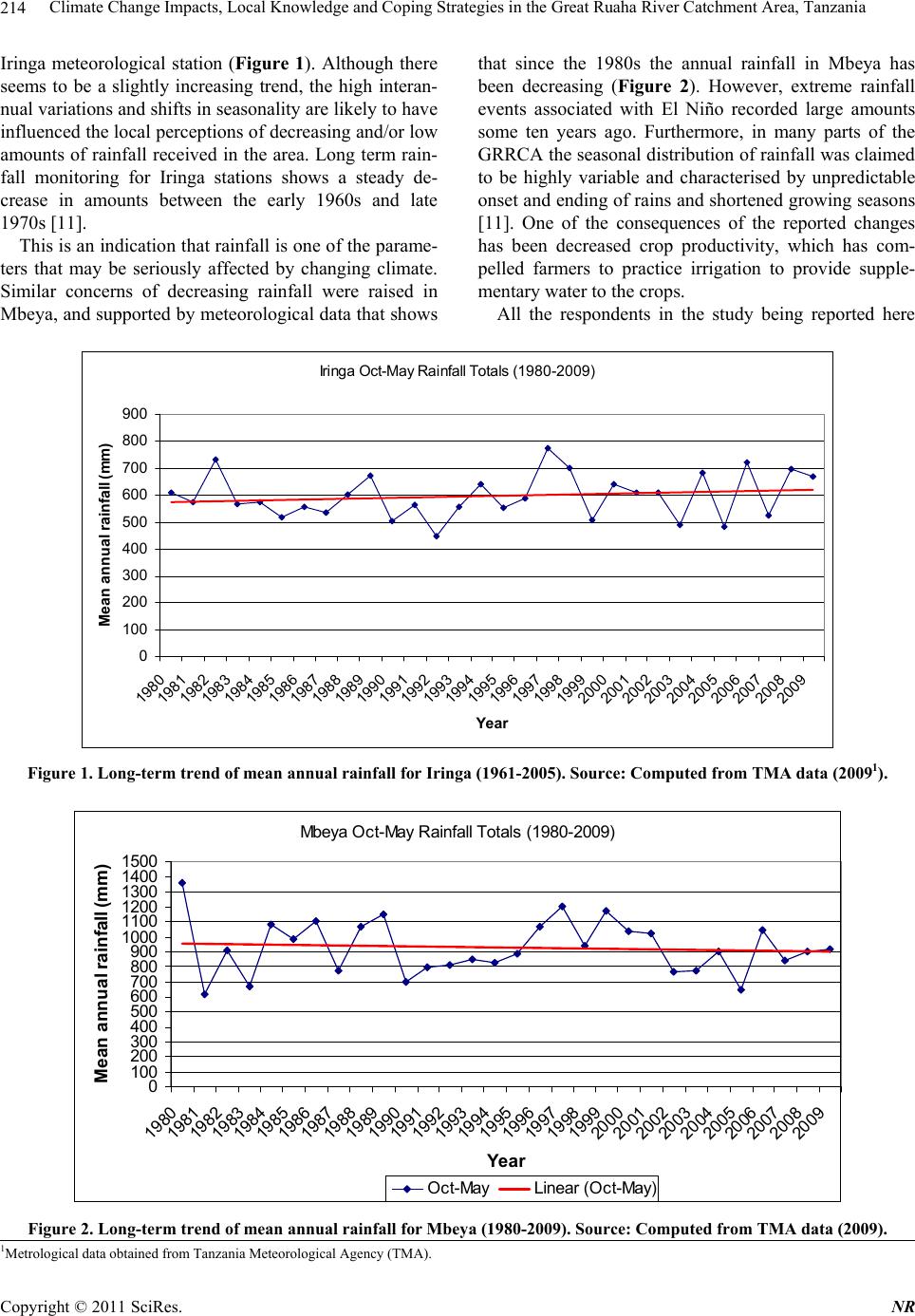 Climate Chang e Impacts, Local Knowledge and Coping Strategies in the Great Ruaha River Catchment Area, Tanzania Copyright © 2011 SciRes. NR 214 Iringa meteorological station (Figure 1). Although there seems to be a slightly increasing trend, the high interan- nual variations and shifts in seasonality are lik ely to h ave influenced the local perceptions of decreasing and/or low amounts of rainfall received in the area. Long term rain- fall monitoring for Iringa stations shows a steady de- crease in amounts between the early 1960s and late 1970s [11]. This is an indication that rainfall is one of the parame- ters that may be seriously affected by changing climate. Similar concerns of decreasing rainfall were raised in Mbeya, and supported by meteorological data that shows that since the 1980s the annual rainfall in Mbeya has been decreasing (Figure 2). However, extreme rainfall events associated with El Niño recorded large amounts some ten years ago. Furthermore, in many parts of the GRRCA the seasonal distributio n of rainfall was claimed to be highly variable and characterised by unpredictable onset and ending of rains and shortened growing seasons [11]. One of the consequences of the reported changes has been decreased crop productivity, which has com- pelled farmers to practice irrigation to provide supple- mentary water to the crops. All the respondents in the study being reported here Iringa Oct- M a y Rainfa l l Tot al s (1 980- 2009) 0 100 200 300 400 500 600 700 800 900 1980 1981 1982 1983 1984 1985 1986 1987 1988 1989 1990 1991 1992 1993 1994 1995 1996 1997 1998 1999 2000 2001 2002 2003 2004 2005 2006 2007 2008 2009 Ye ar M ean annual ra i nf a l l (mm ) Figure 1. Long-term trend of mean annual rainfall for Iringa (1961-2005). Source: Computed from TMA data (20091). Mbeya Oct-May Rainfall Totals (1980-2009) 0 100 200 300 400 500 600 700 800 900 1000 1100 1200 1300 1400 1500 1980 1981 1982 1983 1984 1985 1986 1987 1988 1989 1990 1991 1992 1993 1994 1995 1996 1997 1998 1999 2000 2001 2002 2003 2004 2005 2006 2007 2008 2009 Year M ean a nnual r ainfall ( m m ) Oct-May Linear (Oct-May) Figure 2. Long-term trend of mean annual rainfall for Mbeya (1980-2009). Source: Computed from TMA data (2009). 1Metrologica l data obtained from Tanzania Meteorologic al Agency (TMA). 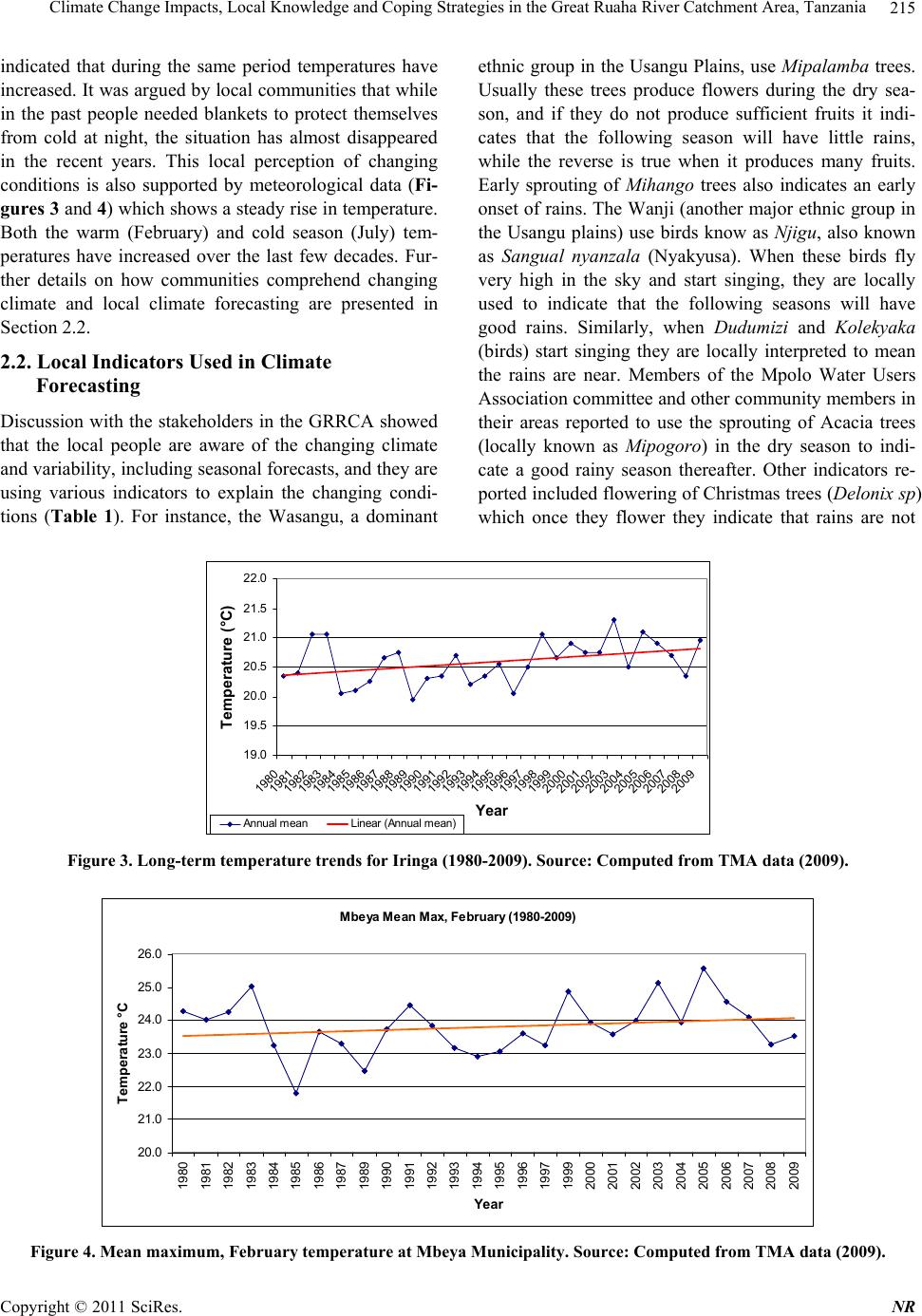 Climate Change Impac ts, Local Knowledge and Coping Strategies in the Great Ruaha River Catchment Area, Tanzania215 indicated that during the same period temperatures have increased. It was argued by local communities that wh ile in the past people needed blankets to protect themselves from cold at night, the situation has almost disappeared in the recent years. This local perception of changing conditions is also supported by meteorological data (Fi- gures 3 and 4) which shows a steady rise in temperature. Both the warm (February) and cold season (July) tem- peratures have increased over the last few decades. Fur- ther details on how communities comprehend changing climate and local climate forecasting are presented in Section 2.2 . 2.2. Local Indicators Used in Climate Forecasting Discussion with the stakeholders in the GRRCA showed that the local people are aware of the changing climate and variability, including seasonal forecasts, and they are using various indicators to explain the changing condi- tions (Table 1). For instance, the Wasangu, a dominant ethnic group in the Usangu Plains, use Mipalamba trees. Usually these trees produce flowers during the dry sea- son, and if they do not produce sufficient fruits it indi- cates that the following season will have little rains, while the reverse is true when it produces many fruits. Early sprouting of Mihango trees also indicates an early onset of ra ins. The Wanji (another major ethn ic group in the Usangu plains) use birds know as Njigu, also known as Sangual nyanzala (Nyakyusa). When these birds fly very high in the sky and start singing, they are locally used to indicate that the following seasons will have good rains. Similarly, when Dudumizi and Kolekyaka (birds) start singing they are locally interpreted to mean the rains are near. Members of the Mpolo Water Users Association committee and other community members in their areas reported to use the sprouting of Acacia trees (locally known as Mipogoro) in the dry season to indi- cate a good rainy season thereafter. Other indicators re- ported included flowering of Christmas trees (Delonix sp) which once they flower they indicate that rains are not 19.0 19.5 20.0 20.5 21.0 21.5 22.0 1980 1981 1982 1983 1984 1985 1986 1987 1988 1989 1990 1991 1992 1993 1994 1995 1996 1997 1998 1999 2000 2001 2002 2003 2004 2005 2006 2007 2008 2009 Year Temperature (°C) Annual meanLinear (Annual mean) Figure 3. Long-term temperature trends for Iringa (1980-2009). Source: Computed from TMA data (2009). Mbeya Mean Max, February (1980-2009) 20.0 21.0 22.0 23.0 24.0 25.0 26.0 1980 1981 1982 1983 1984 1985 1986 1987 1989 1990 1991 1992 1993 1994 1995 1996 1997 1999 2000 2001 2002 2003 2004 2005 2006 2007 2008 2009 Year Tempe ratur e °C Figure 4. Mean maximum, February temperature at Mbeya Municipality. Source: Computed from TMA data (2009). Copyright © 2011 SciRes. NR 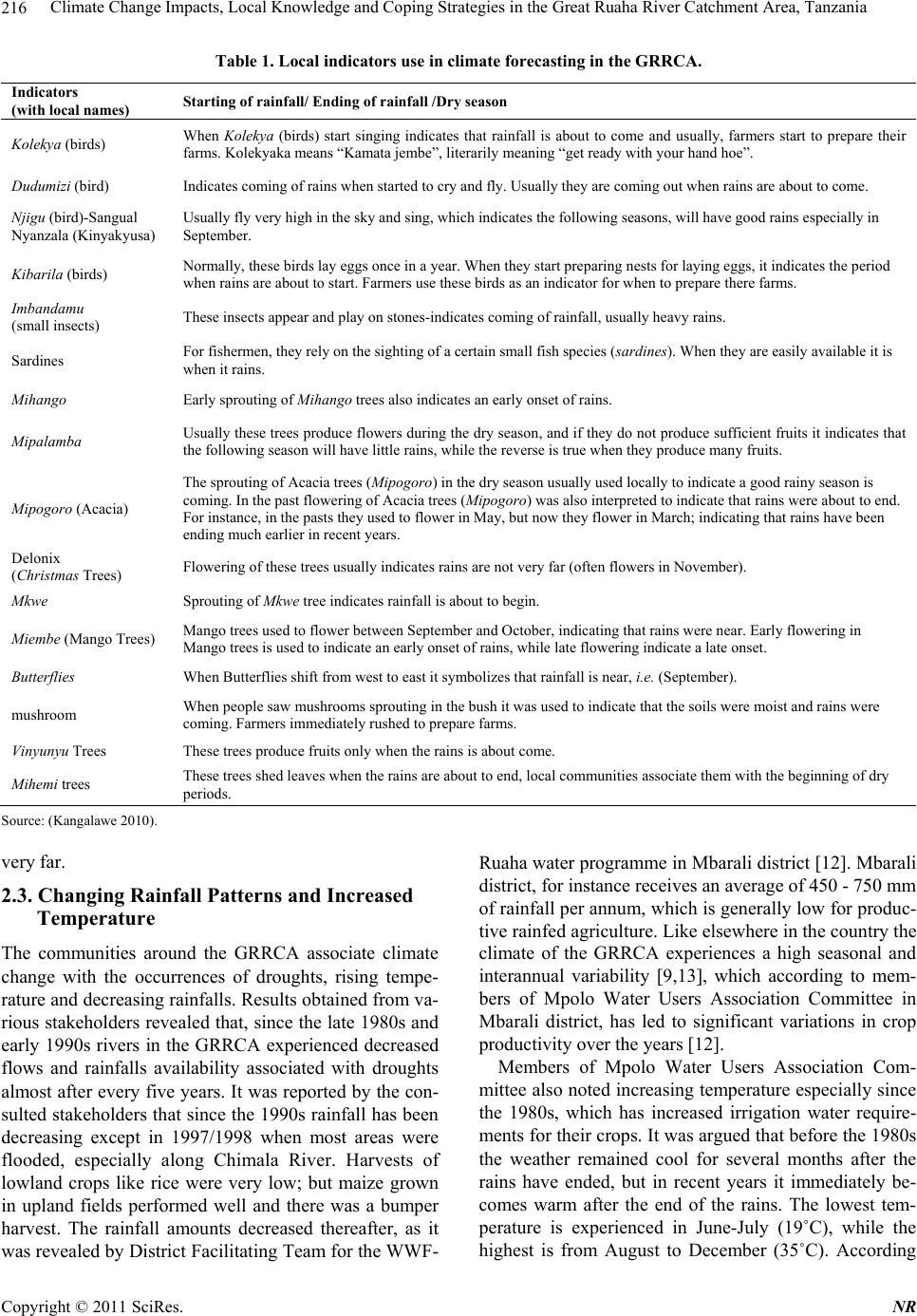 Climate Chang e Impacts, Local Knowledge and Coping Strategies in the Great Ruaha River Catchment Area, Tanzania 216 Table 1. Local indicators use in climate forecasting in the GRRCA. Indicators (with local names) Starting of rainfall/ Ending of rainfall /Dry season Kolekya (birds) When Kolekya (birds) start singing indicates that rainfall is about to come and usually, farmers start to prepare their farms. Kolekyaka means “Kamata jembe”, literarily meaning “get ready with your hand hoe”. Dudumizi (bird) Indicates coming of rains when started to cry and fly. Usually they are coming out when rain s are about to come. Njigu (bird)-Sangual Nyanzala (Kinyakyusa) Usually fly very high in the sky and sing, which indicates the following seasons, will have good rains especially in September. Kibarila (birds) Normally, these birds lay eggs once in a year. When they start preparing nests for laying eggs, it indicates the period when rains are about to start. Farmers use these birds as an indicator for when to prepare there farms. Imbandamu (small insects) These insects appear and play on stones-indicates coming of rainfall, usually heavy rains. Sardines For fishermen, they rely on the sighting of a certain small fish species (sardines). When they are easily available it is when it rains. Mihango Early sprouting o f M ihang o trees also indicates an early onset of rains. Mipalamba Usually these trees produce flowers during the dry season, and if they do not produce sufficient fruits it indicates that the following season will have little rains, while the reverse is true when they produce many fruits. Mipogoro (Acacia) The sprouting of Acacia trees (Mipogoro) in the dry season usually used locally to indicate a good rainy season is coming. In the past flowering of Acacia trees (Mipogoro) was also interpreted to indicate that rains were about to end. For instance, in the pasts they used to flower in May, but now they flower in March; indicating that rains have been ending much earlier in recent years. Delonix (Christmas Trees) Flowering of these trees usually indicates rains are not very far (often flowers in November). Mkwe Sprouting of Mkwe tree indicates rainfall is about to begin. Miembe (Mango Trees) Mango trees used to flower between September and October, indicating that rains were near. Early flowering in Mango trees is used to indica te an early onset of rains, while late flowering indicate a late onset. Butterflies When Butterflies shift from west to east it symbolizes that rainfall is near, i.e. (September). mushroom When people saw mushrooms sprouting in the bush it was used to indicate that the soils were moist and rains were coming. Farmers immediately rushed to prepare farms. Vinyunyu Trees These trees produce fruits only when the rains is about come. Mihemi trees These trees shed leaves when the rains are about to end, local communities associate them with the beginning of dry periods. Source: (Kangalawe 2010). very far. 2.3. Changing Rainfall Patterns and Increased Temperature The communities around the GRRCA associate climate change with the occurrences of droughts, rising tempe- rature and decreasing rainfalls. Results obtain ed from va- rious stakeholders revealed that, since the late 1980s and early 1990s rivers in the GRRCA experienced decreased flows and rainfalls availability associated with droughts almost after every five years. It was reported by the con- sulted stakeholders that since the 1990s rainfall has been decreasing except in 1997/1998 when most areas were flooded, especially along Chimala River. Harvests of lowland crops like rice were very low; but maize grown in upland fields performed well and there was a bumper harvest. The rainfall amounts decreased thereafter, as it was revealed by District Facilitating Team for the WWF- Ruaha water programme in Mbarali district [12]. Mbarali district, for instance receives an average of 450 - 750 mm of rainfall per annum, which is generally low for produc- tive rainfed agricu lture. Like elsewhere in the country the climate of the GRRCA experiences a high seasonal and interannual variability [9,13], which according to mem- bers of Mpolo Water Users Association Committee in Mbarali district, has led to significant variations in crop productivity over the years [12]. Members of Mpolo Water Users Association Com- mittee also noted increasing temperature especially since the 1980s, which has increased irrigation water require- ments for their crops. It was argued that before the 1980s the weather remained cool for several months after the rains have ended, but in recent years it immediately be- comes warm after the end of the rains. The lowest tem- perature is experienced in June-July (19˚C), while the highest is from August to December (35˚C). According Copyright © 2011 SciRes. NR 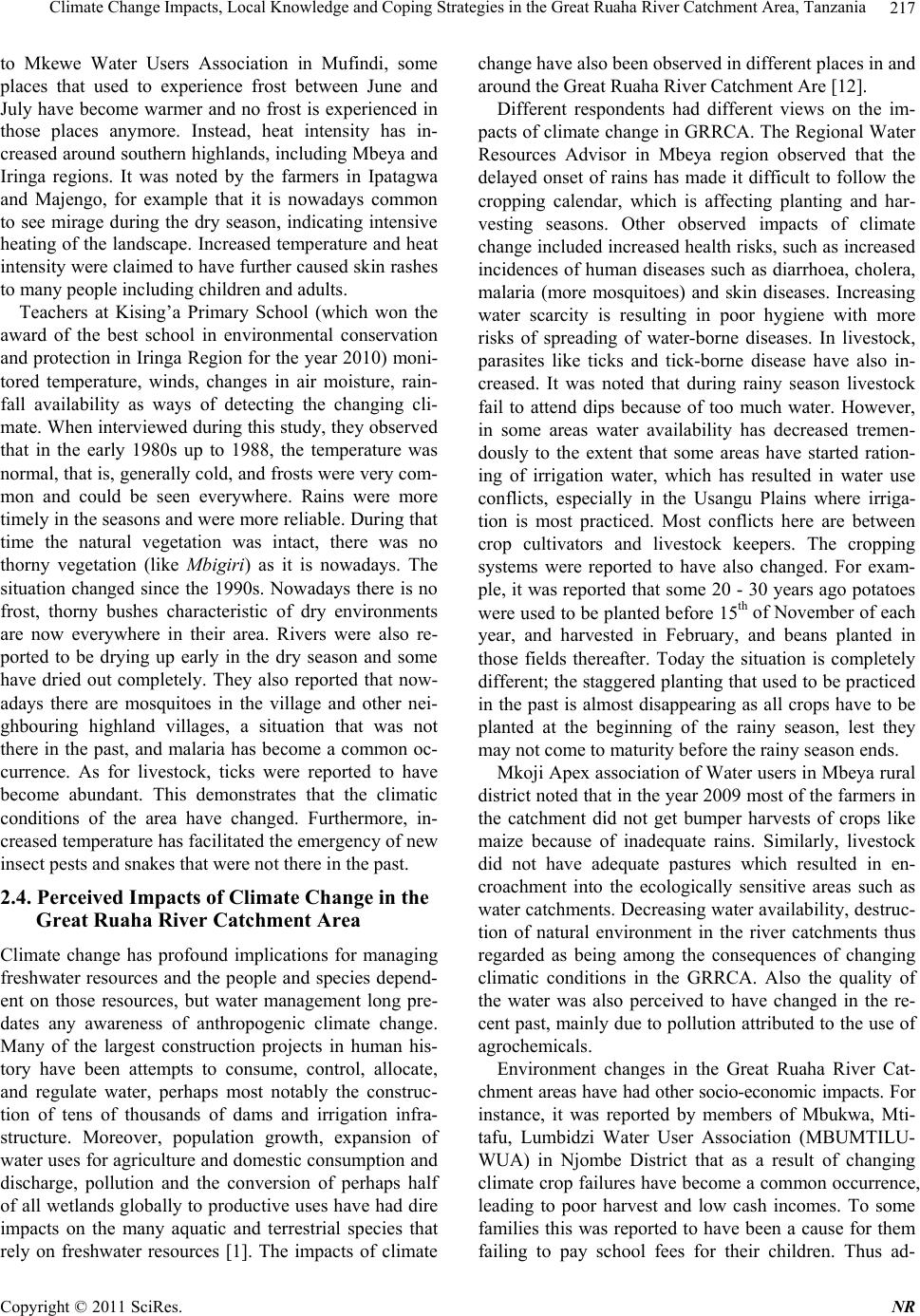 Climate Change Impac ts, Local Knowledge and Coping Strategies in the Great Ruaha River Catchment Area, Tanzania217 to Mkewe Water Users Association in Mufindi, some places that used to experience frost between June and July have become warmer and no frost is experienced in those places anymore. Instead, heat intensity has in- creased around southern highlands, including Mbeya and Iringa regions. It was noted by the farmers in Ipatagwa and Majengo, for example that it is nowadays common to see mirage during the dry season, indicating intensive heating of the landscape. Increased temperature and heat intensity were claimed to have further caused skin rashes to many people including children and adults. Teachers at Kising’a Primary School (which won the award of the best school in environmental conservation and protection in Iringa Region for the year 2010) moni- tored temperature, winds, changes in air moisture, rain- fall availability as ways of detecting the changing cli- mate. When interviewed during this study, they ob served that in the early 1980s up to 1988, the temperature was normal, that is, generally cold, and frosts were very co m- mon and could be seen everywhere. Rains were more timely in the seasons and were more reliable. During that time the natural vegetation was intact, there was no thorny vegetation (like Mbigiri) as it is nowadays. The situation changed since the 1990s. Nowadays there is no frost, thorny bushes characteristic of dry environments are now everywhere in their area. Rivers were also re- ported to be drying up early in the dry season and some have dried out completely. They also reported that now- adays there are mosquitoes in the village and other nei- ghbouring highland villages, a situation that was not there in the past, and malaria has become a common oc- currence. As for livestock, ticks were reported to have become abundant. This demonstrates that the climatic conditions of the area have changed. Furthermore, in- creased temperature has facilitated the emergency of new insect pests and snakes that were not there in the past. 2.4. Perceived Impacts of Climate Change in the Great Ruaha River Catchment Area Climate change has profound implications for managing freshwater resources and the people and species depend- ent on those resources, but water management long pre- dates any awareness of anthropogenic climate change. Many of the largest construction projects in human his- tory have been attempts to consume, control, allocate, and regulate water, perhaps most notably the construc- tion of tens of thousands of dams and irrigation infra- structure. Moreover, population growth, expansion of water uses for agriculture and domestic consumption and discharge, pollution and the conversion of perhaps half of all wetlands globally to productive uses have had dire impacts on the many aquatic and terrestrial species that rely on freshwater resources [1]. The impacts of climate change have also been observed in different places in and around the Great Ruaha River Catchment Are [12]. Different respondents had different views on the im- pacts of climate change in GRRCA. The Regional Water Resources Advisor in Mbeya region observed that the delayed onset of rains has made it difficult to follow the cropping calendar, which is affecting planting and har- vesting seasons. Other observed impacts of climate change included increased health risks, such as increased incidences of human diseases such as diarrhoea, cholera, malaria (more mosquitoes) and skin diseases. Increasing water scarcity is resulting in poor hygiene with more risks of spreading of water-borne diseases. In livestock, parasites like ticks and tick-borne disease have also in- creased. It was noted that during rainy season livestock fail to attend dips because of too much water. However, in some areas water availability has decreased tremen- dously to the extent that some areas have started ration- ing of irrigation water, which has resulted in water use conflicts, especially in the Usangu Plains where irriga- tion is most practiced. Most conflicts here are between crop cultivators and livestock keepers. The cropping systems were reported to have also changed. For exam- ple, it was reported that some 20 - 30 years ago potatoes were used to be planted before 15th of November of each year, and harvested in February, and beans planted in those fields thereafter. Today the situation is completely different; the staggered planting that used to be practiced in the past is almost disappearing as all crops have to be planted at the beginning of the rainy season, lest they may not come to maturity before the rainy season ends. Mkoji Apex association of Water users in Mbeya rural district noted that in the year 2009 most of the farmers in the catchment did not get bumper harvests of crops like maize because of inadequate rains. Similarly, livestock did not have adequate pastures which resulted in en- croachment into the ecologically sensitive areas such as water catchments. Decreasing water availability, destruc- tion of natural environment in the river catchments thus regarded as being among the consequences of changing climatic conditions in the GRRCA. Also the quality of the water was also perceived to have changed in the re- cent past, mainly du e to pollution attribu ted to the use of agrochemicals. Environment changes in the Great Ruaha River Cat- chment areas have had other socio-economic impacts. For instance, it was reported by members of Mbukwa, Mti- tafu, Lumbidzi Water User Association (MBUMTILU- WUA) in Njombe District that as a result of changing climate crop failures have become a common occurrence, leading to poor harvest and low cash incomes. To some families this was reported to have been a cause for them failing to pay school fees for their children. Thus ad- Copyright © 2011 SciRes. NR 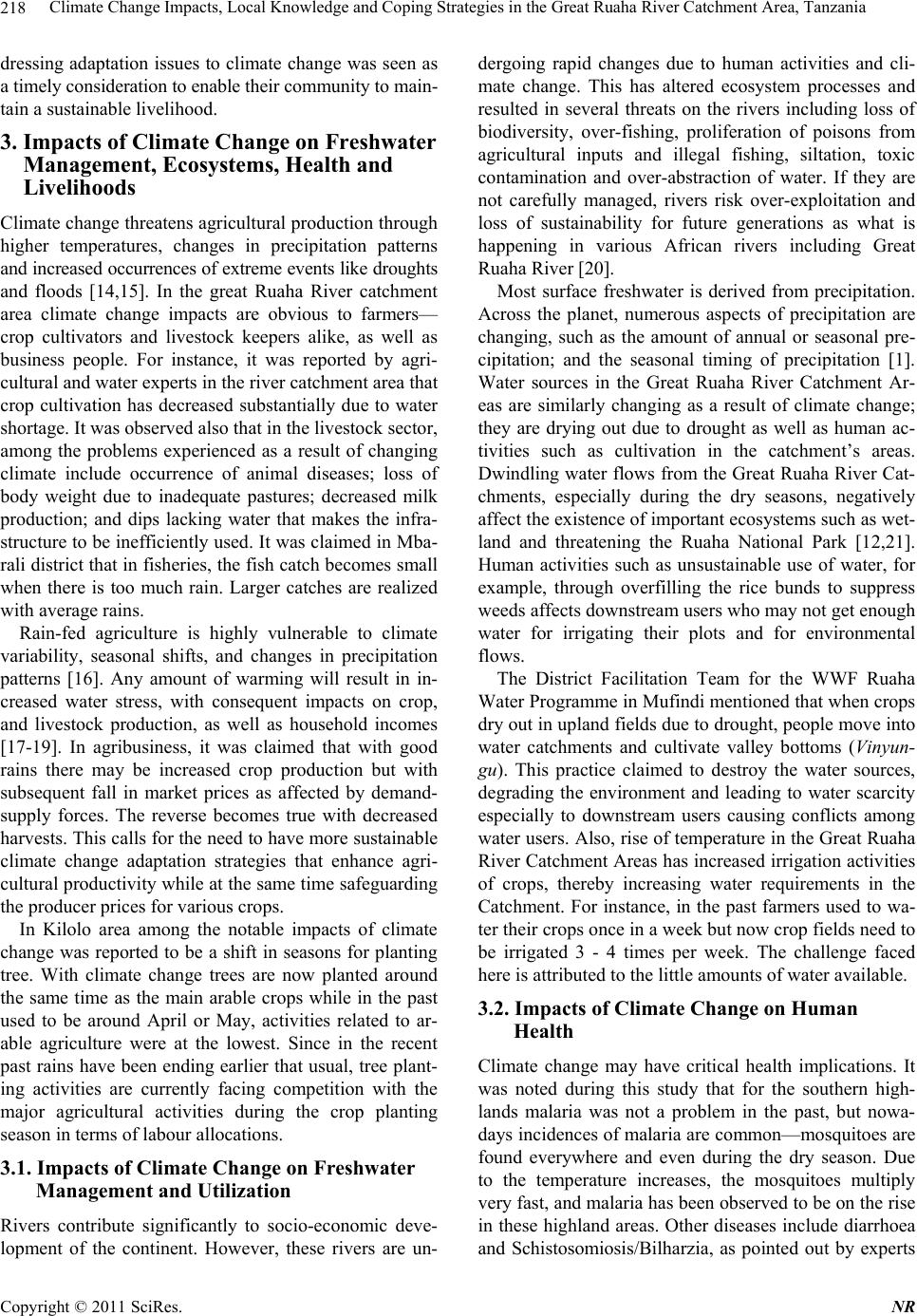 Climate Chang e Impacts, Local Knowledge and Coping Strategies in the Great Ruaha River Catchment Area, Tanzania 218 dressing adaptation issues to climate change was seen as a timely consid eration to enable their community to main- tain a sustainable livelihood. 3. Impacts of Climate Change on Freshwater Management, Ecosystems, Health and Livelihoods Climate change threatens agricultural production throug h higher temperatures, changes in precipitation patterns and increased occurrences of extreme events like droughts and floods [14,15]. In the great Ruaha River catchment area climate change impacts are obvious to farmers— crop cultivators and livestock keepers alike, as well as business people. For instance, it was reported by agri- cultural and water experts in the river catchment area that crop cultivation has decreased substantially due to water shortage. It was observed also that in the liv estock sector, among the problems experienced as a result of changing climate include occurrence of animal diseases; loss of body weight due to inadequate pastures; decreased milk production; and dips lacking water that makes the infra- structure to be inefficiently used. It was claimed in Mba- rali district that in fisheries, the fish catch becomes small when there is too much rain. Larger catches are realized with average rains. Rain-fed agriculture is highly vulnerable to climate variability, seasonal shifts, and changes in precipitation patterns [16]. Any amount of warming will result in in- creased water stress, with consequent impacts on crop, and livestock production, as well as household incomes [17-19]. In agribusiness, it was claimed that with good rains there may be increased crop production but with subsequent fall in market prices as affected by demand- supply forces. The reverse becomes true with decreased harvests. This calls for the need to have more sustainable climate change adaptation strategies that enhance agri- cultural productivity while at the same time safeguarding the producer prices for various crops. In Kilolo area among the notable impacts of climate change was reported to be a shift in seasons for planting tree. With climate change trees are now planted around the same time as the main arable crops while in the past used to be around April or May, activities related to ar- able agriculture were at the lowest. Since in the recent past rains have been ending earlier that usual, tree plant- ing activities are currently facing competition with the major agricultural activities during the crop planting season in terms of labour allocations. 3.1. Impacts of Climate Change on Freshwater Management and Utilization Rivers contribute significantly to socio-economic deve- lopment of the continent. However, these rivers are un- dergoing rapid changes due to human activities and cli- mate change. This has altered ecosystem processes and resulted in several threats on the rivers including loss of biodiversity, over-fishing, proliferation of poisons from agricultural inputs and illegal fishing, siltation, toxic contamination and over-abstraction of water. If they are not carefully managed, rivers risk over-exploitation and loss of sustainability for future generations as what is happening in various African rivers including Great Ruaha River [20]. Most surface freshwater is derived from precipitation. Across the planet, numerous aspects of precipitation are changing, such as the amount of annual or seasonal pre- cipitation; and the seasonal timing of precipitation [1]. Water sources in the Great Ruaha River Catchment Ar- eas are similarly changing as a result of climate change; they are drying out due to drought as well as human ac- tivities such as cultivation in the catchment’s areas. Dwindling water flows from the Great Ruaha River Cat- chments, especially during the dry seasons, negatively affect the existence of important ecosystems such as wet- land and threatening the Ruaha National Park [12,21]. Human activities such as unsustainable use of water, for example, through overfilling the rice bunds to suppress weeds affects downstream users who may not get enough water for irrigating their plots and for environmental flows. The District Facilitation Team for the WWF Ruaha Water Programme in Mufindi mentioned that when crop s dry out in upland f ields due to drou ght, people move in to water catchments and cultivate valley bottoms (Vinyun- gu). This practice claimed to destroy the water sources, degrading the environment and leading to water scarcity especially to downstream users causing conflicts among water users. Also, rise of temperature in the Great Ruaha River Catchment Areas has increased irrigation activities of crops, thereby increasing water requirements in the Catchment. For instance, in the past farmers used to wa- ter their crops once in a week but now crop fields need to be irrigated 3 - 4 times per week. The challenge faced here is attributed to the little amounts of water available. 3.2. Impacts of Climate Change on Human Health Climate change may have critical health implications. It was noted during this study that for the southern high- lands malaria was not a problem in the past, but nowa- days incidences of malaria are common—mosquitoes are found everywhere and even during the dry season. Due to the temperature increases, the mosquitoes multiply very fast, and malaria has been observed to be on the rise in these highland areas. Other diseases include diarrhoea and Schistosomiosis/Bilharzia, as pointed out by experts Copyright © 2011 SciRes. NR 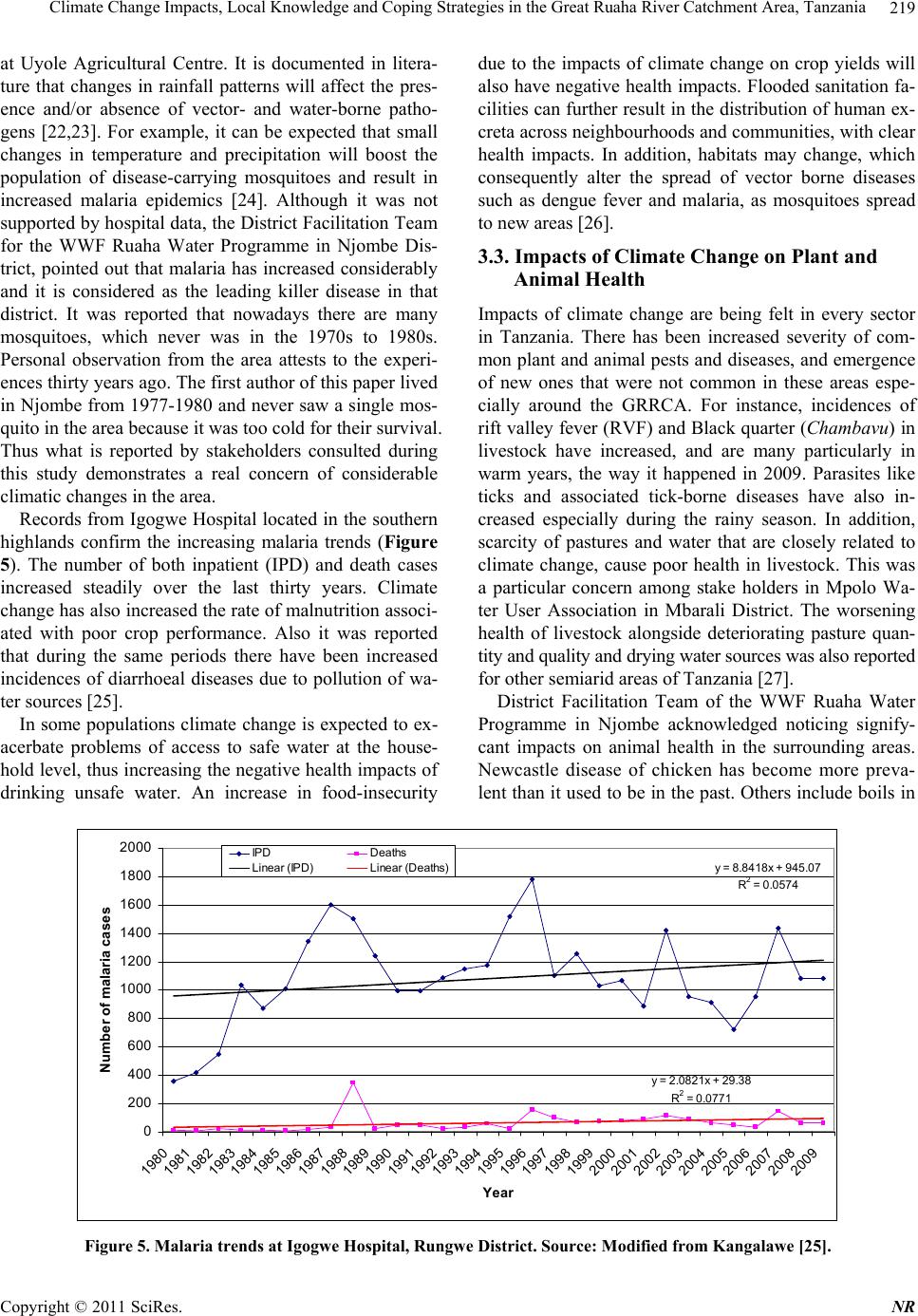 Climate Change Impac ts, Local Knowledge and Coping Strategies in the Great Ruaha River Catchment Area, Tanzania Copyright © 2011 SciRes. NR 219 at Uyole Agricultural Centre. It is documented in litera- ture that changes in rainfall patterns will affect the pres- ence and/or absence of vector- and water-borne patho- gens [22,23]. For example, it can be expected that small changes in temperature and precipitation will boost the population of disease-carrying mosquitoes and result in increased malaria epidemics [24]. Although it was not supported by hospital data, the District Facilitation Team for the WWF Ruaha Water Programme in Njombe Dis- trict, pointed out that malaria has increased considerably and it is considered as the leading killer disease in that district. It was reported that nowadays there are many mosquitoes, which never was in the 1970s to 1980s. Personal observation from the area attests to the experi- ences thirty years ago. The first author of this paper lived in Njombe from 1977-1980 and never saw a single mos- quito in the area becaus e it was too cold for their survival. Thus what is reported by stakeholders consulted during this study demonstrates a real concern of considerable climatic changes in the area. Records from Igogw e Hospital located in the southern highlands confirm the increasing malaria trends (Figure 5). The number of both inpatient (IPD) and death cases increased steadily over the last thirty years. Climate change has also increased the rate of malnutrition associ- ated with poor crop performance. Also it was reported that during the same periods there have been increased incidences of diarrhoeal diseases due to pollution of wa- ter sources [25]. In some populations climate change is expected to ex- acerbate problems of access to safe water at the house- hold level, thus increasing the negative health impacts of drinking unsafe water. An increase in food-insecurity due to the impacts of climate change on crop yields will also have negative health impacts. Flooded sanitation fa- cilities can further result in the distribution of human ex- creta across neighbourhood s and communities, with clear health impacts. In addition, habitats may change, which consequently alter the spread of vector borne diseases such as dengue fever and malaria, as mosquitoes spread to new areas [26]. 3.3. Impacts of Climate Change on Plant and Animal Health Impacts of climate change are being felt in every sector in Tanzania. There has been increased severity of com- mon plant and animal pests and diseases, and emergence of new ones that were not common in these areas espe- cially around the GRRCA. For instance, incidences of rift valley fever (RVF) and Black quarter (Chambavu) in livestock have increased, and are many particularly in warm years, the way it happened in 2009. Parasites like ticks and associated tick-borne diseases have also in- creased especially during the rainy season. In addition, scarcity of pastures and water that are closely related to climate change, cause poor health in livestock. This was a particular concern among stake holders in Mpolo Wa- ter User Association in Mbarali District. The worsening health of livestock alongside deteriorating pasture quan- tity and quality and dry i ng water sources was also report ed for other semiarid areas of Tanzania [27]. District Facilitation Team of the WWF Ruaha Water Programme in Njombe acknowledged noticing signify- cant impacts on animal health in the surrounding areas. Newcastle disease of chicken has become more preva- lent than it used to b e in the past. Others include boils in y = 8 . 84 18x + 945.07 R 2 = 0.0574 y = 2.08 21x + 29. 38 R 2 = 0 . 0771 0 200 400 600 800 1000 1200 1400 1600 1800 2000 1980 1981 1982 1983 1984 1985 1986 1987 1988 1989 1990 1991 1992 1993 1994 1995 1996 1997 1998 1999 2000 2001 2002 2003 2004 2005 2006 2007 2008 2009 Year Numb er of mala ria ca se s IPD Deaths Linear ( IPD)Linear ( Deaths) Figure 5. Malaria trends at Igogwe Hospital, Rungwe District. Source: Modified from Kangalawe [25]. 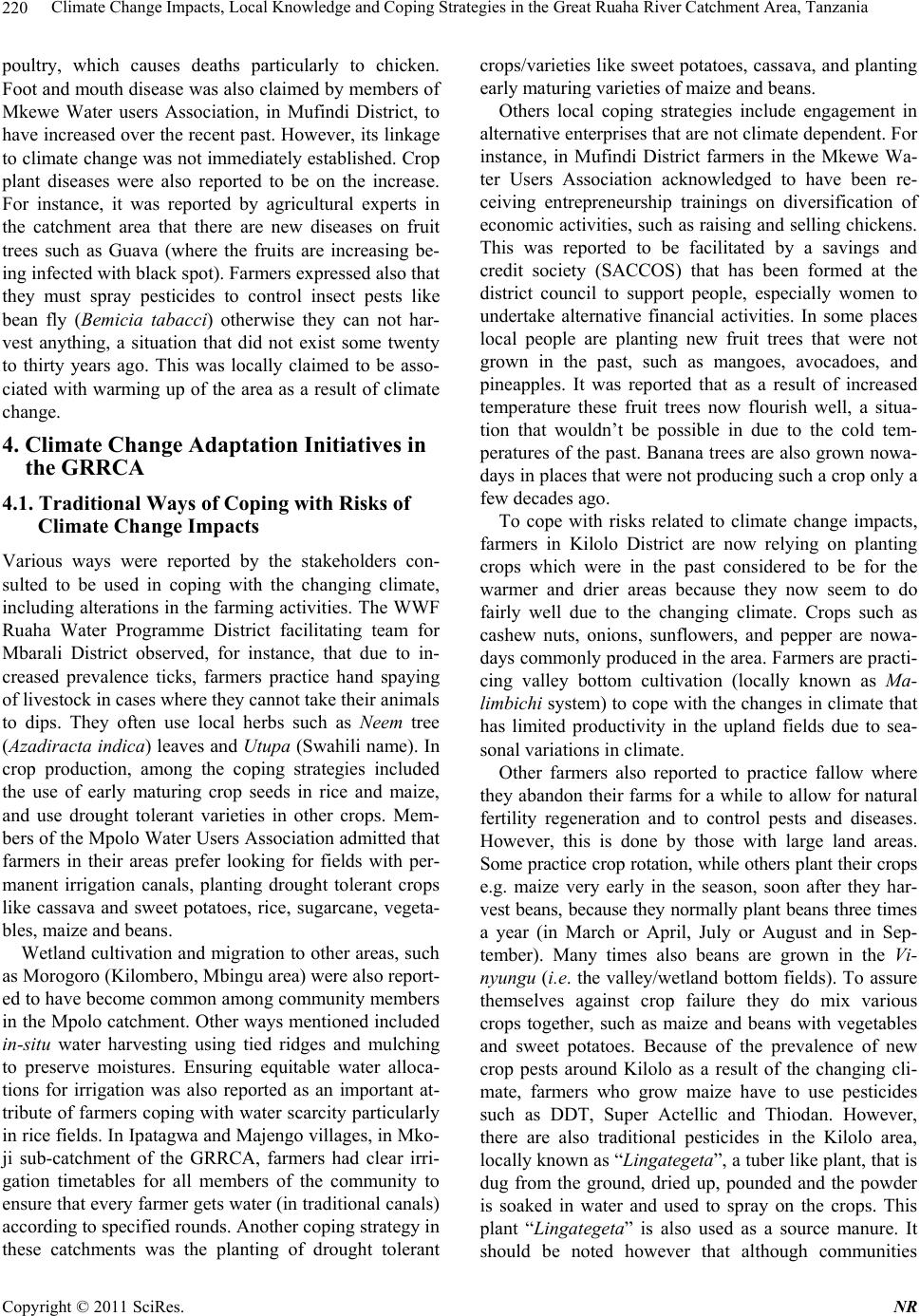 Climate Chang e Impacts, Local Knowledge and Coping Strategies in the Great Ruaha River Catchment Area, Tanzania 220 poultry, which causes deaths particularly to chicken. Foot and mouth disease was also claimed by members of Mkewe Water users Association, in Mufindi District, to have increased over the recent past. However, its linkage to climate change was not immediately established. Crop plant diseases were also reported to be on the increase. For instance, it was reported by agricultural experts in the catchment area that there are new diseases on fruit trees such as Guava (where the fruits are increasing be- ing infected with black spot). Farmers expressed also that they must spray pesticides to control insect pests like bean fly (Bemicia tabacci) otherwise they can not har- vest anything, a situation that did not exist some twenty to thirty years ago. This was locally claimed to be asso- ciated with warming up of the area as a result of climate change. 4. Climate Change Adaptation Initiatives in the GRRCA 4.1. Traditional Ways of Coping with Risks of Climate Change Impacts Various ways were reported by the stakeholders con- sulted to be used in coping with the changing climate, including alterations in the farming activities. The WWF Ruaha Water Programme District facilitating team for Mbarali District observed, for instance, that due to in- creased prevalence ticks, farmers practice hand spaying of livestock in cases where they cannot take their animals to dips. They often use local herbs such as Neem tree (Azadiracta indica) leaves and Utupa (Swahili name). In crop production, among the coping strategies included the use of early maturing crop seeds in rice and maize, and use drought tolerant varieties in other crops. Mem- bers of the Mpolo Water Users Association admitted that farmers in their areas prefer looking for fields with per- manent irrigation canals, planting drought tolerant crops like cassava and sweet potatoes, rice, sugarcane, vegeta- bles, maize and beans. Wetland cultivation and migration to other areas, such as Morogoro (Kilomber o, Mb ingu area) were also report- ed to have become common among community members in the Mpolo catchment. Other ways mentioned included in-situ water harvesting using tied ridges and mulching to preserve moistures. Ensuring equitable water alloca- tions for irrigation was also reported as an important at- tribute of farmers coping with water scarcity particularly in rice fields. In Ipatagwa and Majengo villag es, in Mko- ji sub-catchment of the GRRCA, farmers had clear irri- gation timetables for all members of the community to ensure that every farmer gets water (in traditional canals) according to specified rounds. Another coping strategy in these catchments was the planting of drought tolerant crops/varieties like sweet potatoes, cassava, and planting early maturing varieties of maize and beans. Others local coping strategies include engagement in alternative enterprises that are not climate dependent. For instance, in Mufindi District farmers in the Mkewe Wa- ter Users Association acknowledged to have been re- ceiving entrepreneurship trainings on diversification of economic activities, such as raising and selling chickens. This was reported to be facilitated by a savings and credit society (SACCOS) that has been formed at the district council to support people, especially women to undertake alternative financial activities. In some places local people are planting new fruit trees that were not grown in the past, such as mangoes, avocadoes, and pineapples. It was reported that as a result of increased temperature these fruit trees now flourish well, a situa- tion that wouldn’t be possible in due to the cold tem- peratures of the past. Banana trees are also grown nowa- days in places that were not producing such a crop only a few decades ago. To cope with risks related to climate change impacts, farmers in Kilolo District are now relying on planting crops which were in the past considered to be for the warmer and drier areas because they now seem to do fairly well due to the changing climate. Crops such as cashew nuts, onions, sunflowers, and pepper are nowa- days commonly produced in the area. Farmers are practi- cing valley bottom cultivation (locally known as Ma- limbichi system) to cope with the changes in climate that has limited productivity in the upland fields due to sea- sonal variations in climate. Other farmers also reported to practice fallow where they abandon their farms for a while to allow for natural fertility regeneration and to control pests and diseases. However, this is done by those with large land areas. Some practice crop rotation, while others plant their crops e.g. maize very early in the season, soon after they har- vest beans, because they normally plant beans three times a year (in March or April, July or August and in Sep- tember). Many times also beans are grown in the Vi- nyungu (i.e. the valley/wetland bottom fields). To assure themselves against crop failure they do mix various crops together, such as maize and beans with vegetables and sweet potatoes. Because of the prevalence of new crop pests around Kilolo as a result of the changing cli- mate, farmers who grow maize have to use pesticides such as DDT, Super Actellic and Thiodan. However, there are also traditional pesticides in the Kilolo area, locally known as “Lingategeta”, a tuber like plant, that is dug from the ground, dried up, pounded and the powder is soaked in water and used to spray on the crops. This plant “Lingategeta” is also used as a source manure. It should be noted however that although communities Copyright © 2011 SciRes. NR 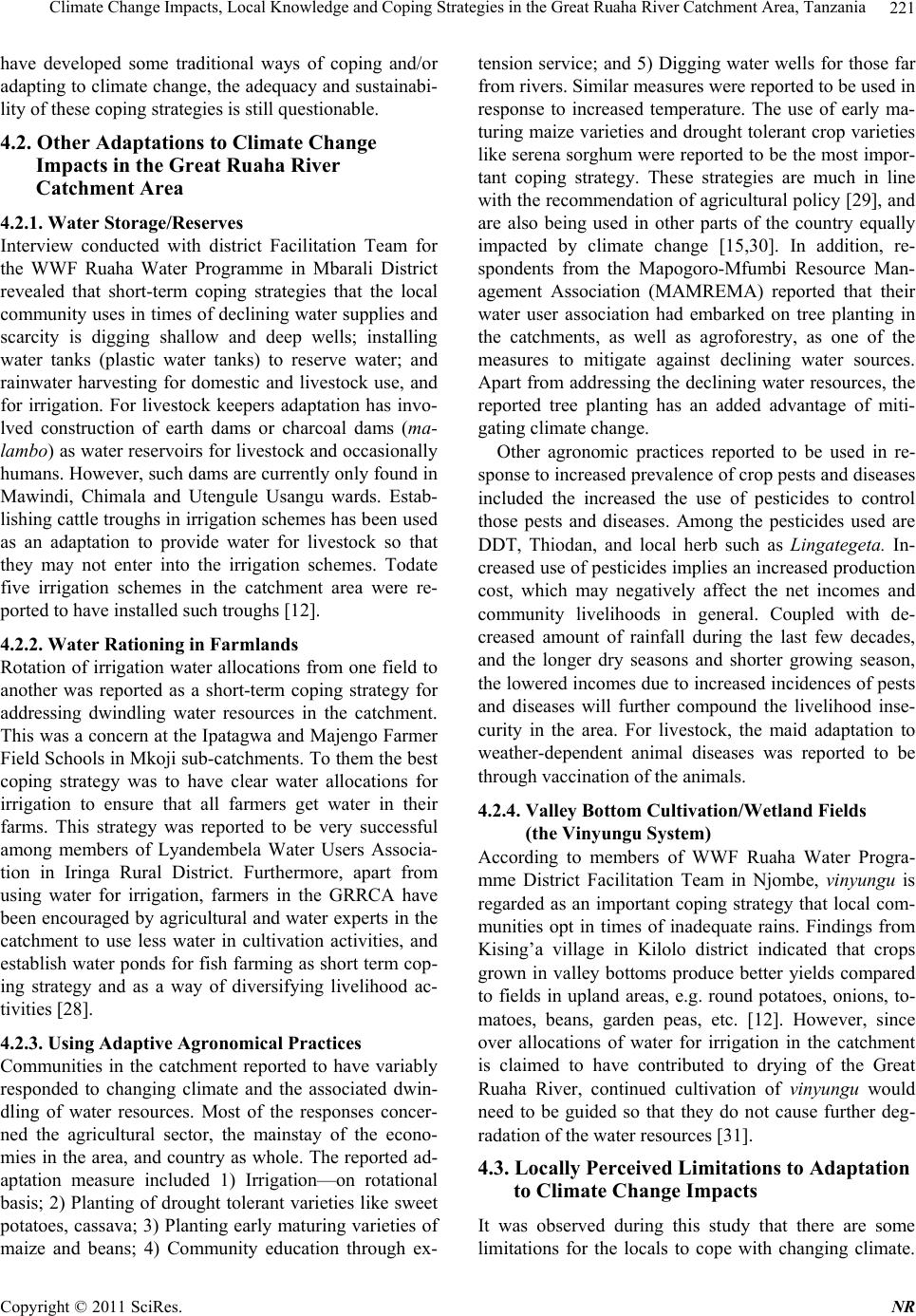 Climate Change Impac ts, Local Knowledge and Coping Strategies in the Great Ruaha River Catchment Area, Tanzania221 have developed some traditional ways of coping and/or adapting to climate change, the adequacy and sustainabi- lity of these coping strategies is still questionable. 4.2. Other Adaptations to Climate Change Impacts in the Great Ruaha River Catchment Area 4.2.1. W ater Storage/Res erves Interview conducted with district Facilitation Team for the WWF Ruaha Water Programme in Mbarali District revealed that short-term coping strategies that the local community uses in times of declining water supplies and scarcity is digging shallow and deep wells; installing water tanks (plastic water tanks) to reserve water; and rainwater harvesting for domestic and livestock use, and for irrigation. For livestock keepers adaptation has invo- lved construction of earth dams or charcoal dams (ma- lambo) as water reservoirs for livestock and occasionally humans. However, such dams are currently only found in Mawindi, Chimala and Utengule Usangu wards. Estab- lishing cattle trough s in irrigation schemes has been used as an adaptation to provide water for livestock so that they may not enter into the irrigation schemes. Todate five irrigation schemes in the catchment area were re- ported to have installed such troughs [12]. 4.2.2. W ater Ratio ning in F a rm lands Rotation of irrigation water allocations from one field to another was reported as a short-term coping strategy for addressing dwindling water resources in the catchment. This was a concern at the Ipatagwa and Majengo Farmer Field Schools in Mkoji sub-catchments. To them the best coping strategy was to have clear water allocations for irrigation to ensure that all farmers get water in their farms. This strategy was reported to be very successful among members of Lyandembela Water Users Associa- tion in Iringa Rural District. Furthermore, apart from using water for irrigation, farmers in the GRRCA have been en couraged by agr icultural and water ex perts in the catchment to use less water in cultivation activities, and establish water ponds for fish farming as short term cop- ing strategy and as a way of diversifying livelihood ac- tivities [28]. 4.2.3. Using A daptive Agronomical Practices Communities in the catchment reported to have variably responded to changing climate and the associated dwin- dling of water resources. Most of the responses concer- ned the agricultural sector, the mainstay of the econo- mies in the area, and country as whole. The reported ad- aptation measure included 1) Irrigation—on rotational basis; 2) Planting of drought tolerant varieties like sweet potatoes, cassava; 3) Planting early maturing varieties of maize and beans; 4) Community education through ex- tension service; and 5) Digging water wells for those far from rivers. Similar measures were reported to be used in response to increased temperature. The use of early ma- turing maize varieties and drought to lerant crop varieties like serena sorghum were reported to be the most impor- tant coping strategy. These strategies are much in line with the recommendation of agricultu ral policy [29], and are also being used in other parts of the country equally impacted by climate change [15,30]. In addition, re- spondents from the Mapogoro-Mfumbi Resource Man- agement Association (MAMREMA) reported that their water user association had embarked on tree planting in the catchments, as well as agroforestry, as one of the measures to mitigate against declining water sources. Apart from addressing the declining water resources, the reported tree planting has an added advantage of miti- gating climate change. Other agronomic practices reported to be used in re- sponse to increased prevalence of crop pests and diseases included the increased the use of pesticides to control those pests and diseases. Among the pesticides used are DDT, Thiodan, and local herb such as Lingategeta. In- creased use of pesticides implies an increased production cost, which may negatively affect the net incomes and community livelihoods in general. Coupled with de- creased amount of rainfall during the last few decades, and the longer dry seasons and shorter growing season, the lowered incomes due to increased incidences of pests and diseases will further compound the livelihood inse- curity in the area. For livestock, the maid adaptation to weather-dependent animal diseases was reported to be through vaccination of the animals. 4.2.4. Valley Bottom Cultivation/Wetland Fields (the Vinyungu S ystem) According to members of WWF Ruaha Water Progra- mme District Facilitation Team in Njombe, vinyungu is regarded as an important coping strategy that local com- munities opt in times of inadequate rains. Findings from Kising’a village in Kilolo district indicated that crops grown in valley bottoms produce better yields compared to fields in upland areas, e.g. round potatoes, onions, to- matoes, beans, garden peas, etc. [12]. However, since over allocations of water for irrigation in the catchment is claimed to have contributed to drying of the Great Ruaha River, continued cultivation of vinyungu would need to be guided so that they do not cause further deg- radation of the wate r r esources [ 31]. 4.3. Locally Perceived Limitations to Adaptation to Climate Change Impacts It was observed during this study that there are some limitations for the locals to cope with changing climate. Copyright © 2011 SciRes. NR 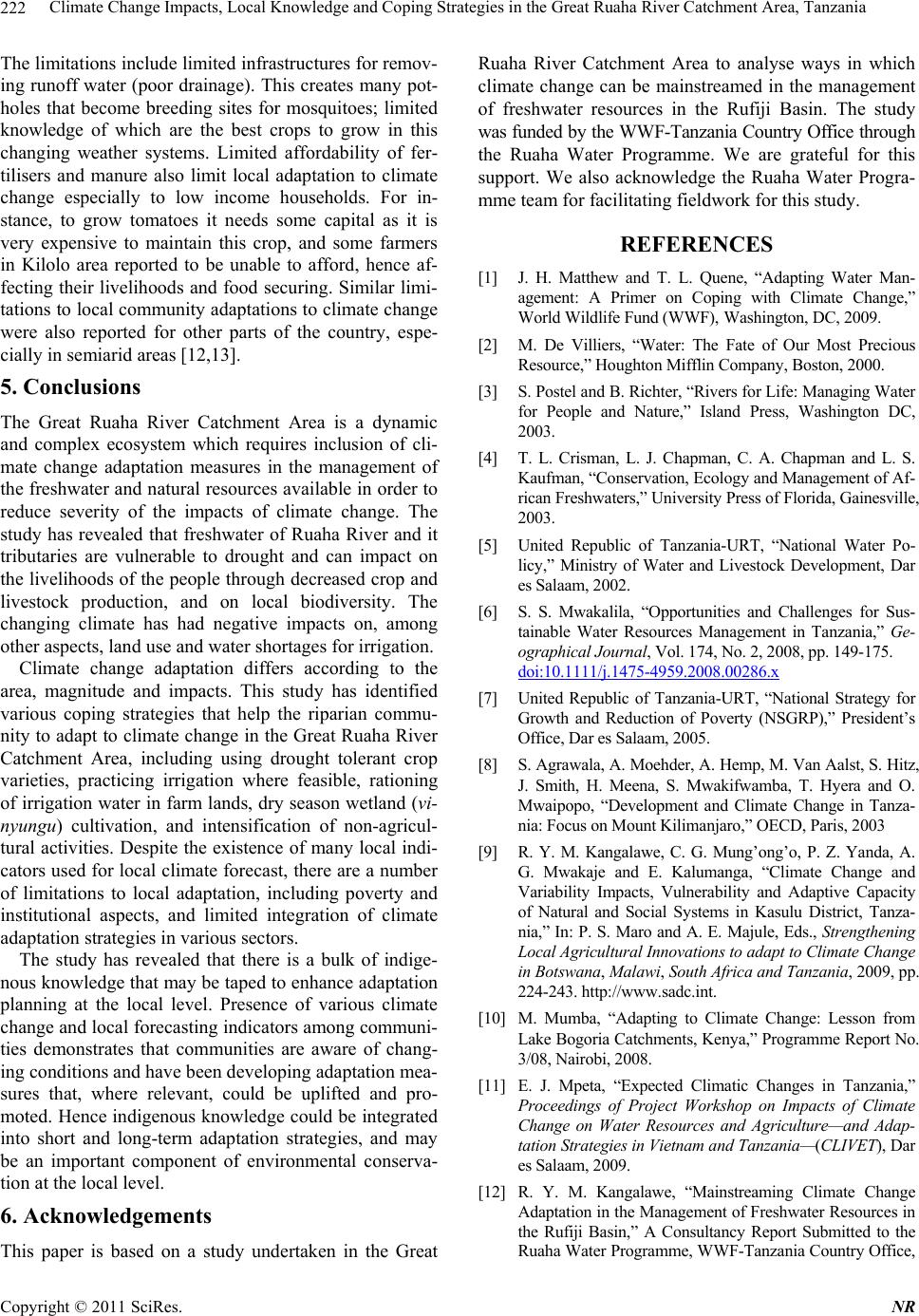 Climate Chang e Impacts, Local Knowledge and Coping Strategies in the Great Ruaha River Catchment Area, Tanzania 222 The limitations includ e limited infrastruc tures for remov- ing runoff water (poor drainage). This creates many pot- holes that become breeding sites for mosquitoes; limited knowledge of which are the best crops to grow in this changing weather systems. Limited affordability of fer- tilisers and manure also limit local adaptation to climate change especially to low income households. For in- stance, to grow tomatoes it needs some capital as it is very expensive to maintain this crop, and some farmers in Kilolo area reported to be unable to afford, hence af- fecting their livelihoods and food securing. Similar limi- tations to local community adaptations to climate change were also reported for other parts of the country, espe- cially in semiarid areas [12,13]. 5. Conclusions The Great Ruaha River Catchment Area is a dynamic and complex ecosystem which requires inclusion of cli- mate change adaptation measures in the management of the freshwater and natural resources available in order to reduce severity of the impacts of climate change. The study has revealed that freshwater of Ruaha River and it tributaries are vulnerable to drought and can impact on the livelihoods of the people through decreased crop and livestock production, and on local biodiversity. The changing climate has had negative impacts on, among other aspects, land use and water shortages for irrigation. Climate change adaptation differs according to the area, magnitude and impacts. This study has identified various coping strategies that help the riparian commu- nity to adapt to climate change in the Great Ruaha River Catchment Area, including using drought tolerant crop varieties, practicing irrigation where feasible, rationing of irrigation water in farm lands, dry season wetland (vi- nyungu) cultivation, and intensification of non-agricul- tural activities. Despite the existence of many local indi- cators used for local climate forecast, there are a number of limitations to local adaptation, including poverty and institutional aspects, and limited integration of climate adaptation strategies in various sectors. The study has revealed that there is a bulk of indige- nous knowledge that may be taped to enhance adaptation planning at the local level. Presence of various climate change and local forecasting indicators among communi- ties demonstrates that communities are aware of chang- ing conditions and have been developing adaptation mea- sures that, where relevant, could be uplifted and pro- moted. Hence indigenous knowledge could be integrated into short and long-term adaptation strategies, and may be an important component of environmental conserva- tion at the local level. 6. Acknowledgements This paper is based on a study undertaken in the Great Ruaha River Catchment Area to analyse ways in which climate change can be mainstreamed in the management of freshwater resources in the Rufiji Basin. The study was funded by the WW F-Tanzania Country Office through the Ruaha Water Programme. We are grateful for this support. We also acknowledge the Ruaha Water Progra- mme team for facilitating fieldwork for this study. REFERENCES [1] J. H. Matthew and T. L. Quene, “Adapting Water Man- agement: A Primer on Coping with Climate Change,” World Wildlife Fund (WWF), Washington, DC, 2009. [2] M. De Villiers, “Water: The Fate of Our Most Precious Resource,” Houghton Mifflin Company, Boston, 2000. [3] S. Postel and B. Richter, “River s for Life: Managing Water for People and Nature,” Island Press, Washington DC, 2003. [4] T. L. Crisman, L. J. Chapman, C. A. Chapman and L. S. Kaufman, “Conservation, Ecology and Manageme nt of Af - rican Freshwaters,” University Press of Florida, Gainesville, 2003. [5] United Republic of Tanzania-URT, “National Water Po- licy,” Ministry of Water and Livestock Development, Dar es Salaam, 2002. [6] S. S. Mwakalila, “Opportunities and Challenges for Sus- tainable Water Resources Management in Tanzania,” Ge- ographical Journal, Vol. 174, No. 2, 2008, pp. 149-175. doi:10.1111/j.1475-4959.2 008. 00286.x [7] United Republic of Tanzania-URT, “National Strategy for Growth and Reduction of Poverty (NSGRP),” President’s Office, Dar es Salaam, 2005. [8] S. Agrawala, A. Moeh der, A. Hemp, M. Van Aalst, S. Hitz, J. Smith, H. Meena, S. Mwakifwamba, T. Hyera and O. Mwaipopo, “Development and Climate Change in Tanza- nia: Focus on Mount Kilimanjaro,” OECD, Paris, 2003 [9] R. Y. M. Kangalawe, C. G. Mung’ong’o, P. Z. Yanda, A. G. Mwakaje and E. Kalumanga, “Climate Change and Variability Impacts, Vulnerability and Adaptive Capacity of Natural and Social Systems in Kasulu District, Tanza- nia,” In: P. S. Maro and A. E. Majule, Eds., Strengthening Local Agricultural Innovation s to adapt to Climate Change in Botswana, Malawi, South Africa and Tanzania, 2009, pp. 224-243. http://www.sadc.int. [10] M. Mumba, “Adapting to Climate Change: Lesson from Lake Bogoria Catchments, Keny a,” Programme Report No. 3/08, Nairobi, 2008. [11] E. J. Mpeta, “Expected Climatic Changes in Tanzania,” Proceedings of Project Workshop on Impacts of Climate Change on Water Resources and Agriculture—and Adap- tation Strategies in Vietnam and Tanzania—(CLIVET), Dar es Salaam, 2009. [12] R. Y. M. Kangalawe, “Mainstreaming Climate Change Adaptation in the Management of Freshwater Resources in the Rufiji Basin,” A Consultancy Report Submitted to the Ruaha Water Programme, WWF-Tanzania Country Office, Copyright © 2011 SciRes. NR 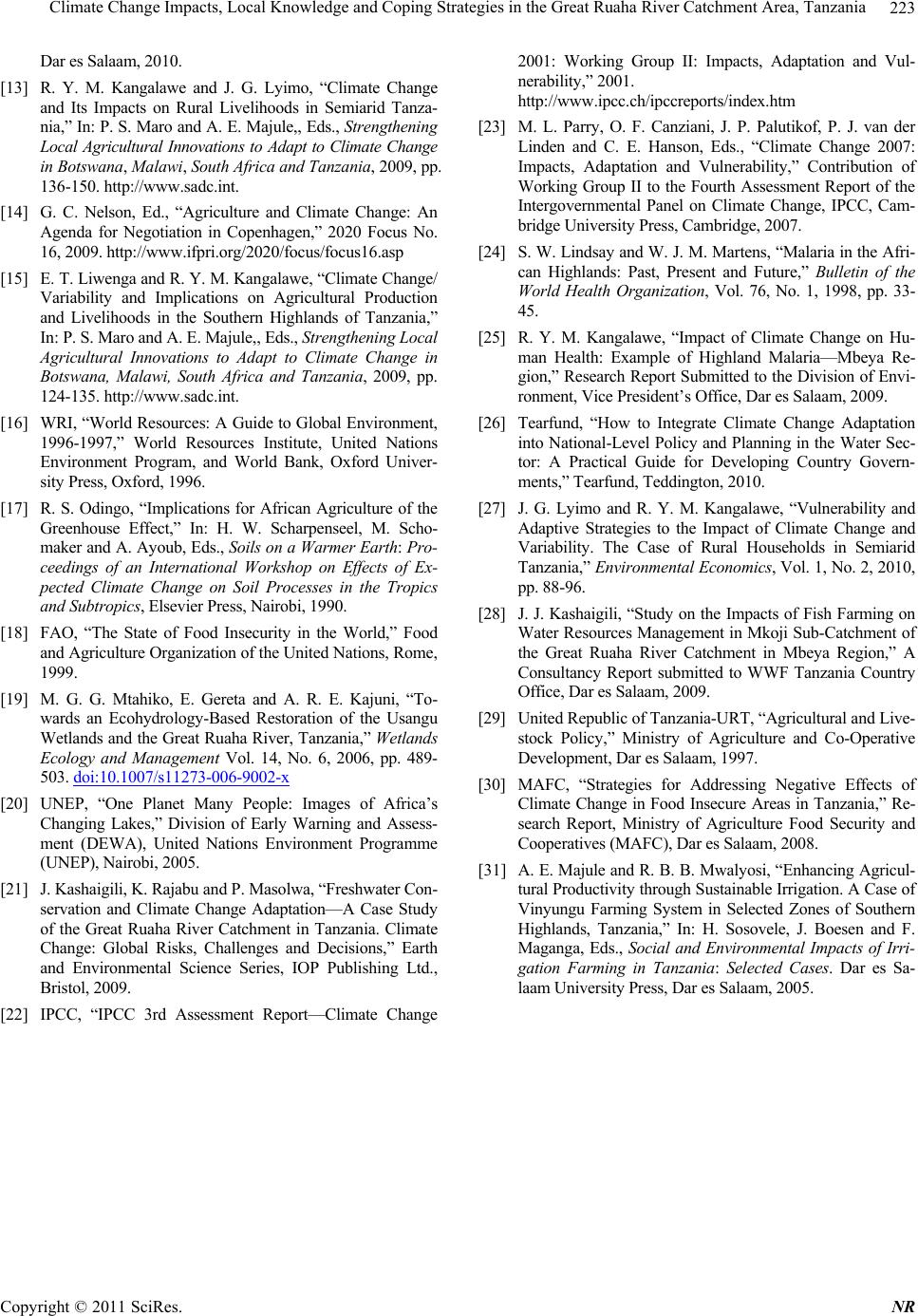 Climate Change Impac ts, Local Knowledge and Coping Strategies in the Great Ruaha River Catchment Area, Tanzania Copyright © 2011 SciRes. NR 223 Dar es Salaam, 2010. [13] R. Y. M. Kangalawe and J. G. Lyimo, “Climate Change and Its Impacts on Rural Livelihoods in Semiarid Tanza- nia,” In: P. S. Maro and A. E. Majule,, Eds., Strengthening Local Agricultural Innovations to Adapt to Climate Change in Botswana, Malawi, South Africa and Tan za nia, 2009, pp. 136-150. http://www.sadc.int. [14] G. C. Nelson, Ed., “Agriculture and Climate Change: An Agenda for Negotiation in Copenhagen,” 2020 Focus No. 16, 2009. http://www.ifpri.org/2020/focus/focus16.asp [15] E. T. Liwenga and R. Y. M. Kangalawe, “Climate Change/ Variability and Implications on Agricultural Production and Livelihoods in the Southern Highlands of Tanzania,” In: P. S. Maro and A. E. Majule,, Eds., Strengthening Local Agricultural Innovations to Adapt to Climate Change in Botswana, Malawi, South Africa and Tanzania, 2009, pp. 124-135. http://www.sadc.int. [16] WRI, “World Resources: A Guide to Global Envi ronment, 1996-1997,” World Resources Institute, United Nations Environment Program, and World Bank, Oxford Univer- sity Press, Oxford, 1996. [17] R. S. Odingo, “Implications for African Agriculture of the Greenhouse Effect,” In: H. W. Scharpenseel, M. Scho- maker and A. Ayoub, Eds., Soils on a Warme r Earth: Pro- ceedings of an International Workshop on Effects of Ex- pected Climate Change on Soil Processes in the Tropics and Subtropics, Elsevier Press, Nairobi, 1990. [18] FAO, “The State of Food Insecurity in the World,” Food and Agriculture Organization of the United Nations, Rome, 1999. [19] M. G. G. Mtahiko, E. Gereta and A. R. E. Kajuni, “To- wards an Ecohydrology-Based Restoration of the Usangu Wetlands and the Great Ruaha River, Tanzania,” Wetlands Ecology and Management Vol. 14, No. 6, 2006, pp. 489- 503. doi:10.1007/s11 273-00 6-9 002-x [20] UNEP, “One Planet Many People: Images of Africa’s Changing Lakes,” Division of Early Warning and Assess- ment (DEWA), United Nations Environment Programme (UNEP), Nairobi, 2005. [21] J. Kashaigili, K. Rajabu and P. Masolwa, “Freshwater Con- servation and Climate Change Adaptation—A Case Study of the Great Ruaha River Catchment in Tanzania. Climate Change: Global Risks, Challenges and Decisions,” Earth and Environmental Science Series, IOP Publishing Ltd., Bristol, 2009. [22] IPCC, “IPCC 3rd Assessment Report—Climate Change 2001: Working Group II: Impacts, Adaptation and Vul- nerability,” 2001. http://www.ipcc.ch/ipccreports/index.htm [23] M. L. Parry, O. F. Canziani, J. P. Palutikof, P. J. van der Linden and C. E. Hanson, Eds., “Climate Change 2007: Impacts, Adaptation and Vulnerability,” Contribution of Working Group II to the Fourth Assessment Report of the Intergovernmental Panel on Climate Change, IPCC, Cam- bridge University Press, Cambridge, 2007. [24] S. W. Lindsay and W. J. M. Martens, “Ma laria in the Afri- can Highlands: Past, Present and Future,” Bulletin of the World Health Organization, Vol. 76, No. 1, 1998, pp. 33- 45. [25] R. Y. M. Kangalawe, “Impact of Climate Change on Hu- man Health: Example of Highland Malaria—Mbeya Re- gion,” Research Report Submitted to the Divi sion of Envi- ronment, Vice President’s Office, Dar es Salaam, 2009. [26] Tearfund, “How to Integrate Climate Change Adaptation into National-Level Policy and Planning in the Water Sec- tor: A Practical Guide for Developing Country Govern- ments,” Tearfund, Teddington, 2010. [27] J. G. Lyimo and R. Y. M. Kangalawe, “Vulnerability and Adaptive Strategies to the Impact of Climate Change and Variability. The Case of Rural Households in Semiarid Tanzania,” Environmental Economics, Vol. 1, No. 2, 2010, pp. 88-96. [28] J. J. Kashaigili, “Study on the Impacts of Fish Farming on Water Resources Manage ment in Mkoji Sub-Catch ment of the Great Ruaha River Catchment in Mbeya Region,” A Consultancy Report submitted to WWF Tanzania Country Office, Dar es Salaam, 2009. [29] United Republic of Tanzania-URT, “Agricultural and Live- stock Policy,” Ministry of Agriculture and Co-Operative Development, Dar es Salaam, 1997. [30] MAFC, “Strategies for Addressing Negative Effects of Climate Change in Food Insecure Areas in Tanzania,” Re- search Report, Ministry of Agriculture Food Security and Cooperatives (MAFC), Dar es Salaam, 2008. [31] A. E. Majule and R. B. B. Mwalyosi, “Enhancing Agric ul- tural Productivity through Sustai nable Irri gation. A Case o f Vinyungu Farming System in Selected Zones of Southern Highlands, Tanzania,” In: H. Sosovele, J. Boesen and F. Maganga, Eds., Social and Environmental Impacts of Irri- gation Farming in Tanzania: Selected Cases. Dar es Sa- laam University Press, Dar es Salaam, 2005.
|